A forest is a large area covered with trees and plants. It is home to many animals and microorganisms. Forests help produce oxygen, absorb carbon dioxide, regulate the water cycle, and provide resources like wood and food. There are different types of forests, such as tropical, temperate, and boreal, found in various parts of the world.
Forests also act as natural green lungs and water purification systems to the world.
Forests - Our Lifeline Class 7 Notes Science Chapter 12
| Table of contents |

|
| Visit to a Forest |

|
| Forestry Structure |

|
| What is a Food Chain? |

|
| Why are Forests called Green Lungs of the Planet? |

|
| What is Deforestation? |

|
| Conservation of Forests |

|
| Keywords |

|
What is a Forest?

Visit to a Forest
Have you ever visited a forest? Do you wonder what it could be like if you visit one? Let's take you through this journey!- When you enter the forest, you'll see a thick green cover of treetops. The trees are so tall and close together that you might not see the ground below.
- The forest is peaceful with a cool breeze that feels refreshing.
- While you're exploring, you might hear birds chirping and rustling in the trees. Sometimes, monkeys in the trees make noises that can scare the birds, but this is normal in the forest.
- In the deeper parts of the forest, there are many animals like wild boar, bison, jackals, porcupines, and even elephants.
- It's important to stay on the paths and not go too far into the forest to stay safe.
- In the forest, the ground can be bumpy and covered with many trees. You might see different kinds of trees like sal, teak, neem, and bamboo. There are also shrubs, herbs, and grasses all around.
- The forest floor and the trees are often covered with vines and creepers. The sunlight doesn't shine through very brightly because the leaves of the trees make it quite dark inside the forest.

Forestry Structure
Layer of Emergence
This is the topmost layer in the forest, featuring very tall trees that rise above the others. These trees have crowns at their tops and provide habitat for birds and insects. They receive ample sunlight and endure stronger winds.
Canopy
The canopy is a dense layer of the trees' tops in the forest. It blocks sunlight from reaching the forest floor, creating a shady environment. Many animals reside in this layer, benefiting from the plentiful food and shelter available.
Understory
The understory lies just below the canopy and consists of smaller trees, bushes, and vines. This layer receives limited sunlight due to the thick leaves above, resulting in high humidity. It supports a variety of animals, birds, and insects that thrive in these conditions.
Forest Floor
The forest floor is the lowest layer, covered with fallen leaves, branches, and other organic matter. Microorganisms decompose this material, releasing nutrients that aid the growth of plants and other species. This layer is home to insects, fungi, small animals, and microorganisms.
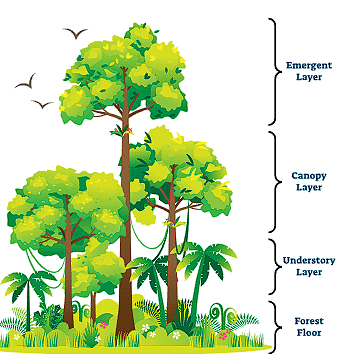
The different parts of the forest depend on each other. Forests play a key role in influencing the climate, water cycle, and air quality. Furthermore, they protect the soil from erosion.
What is a Food Chain?
A food chain is a way to show how energy flows through an ecosystem by showing who eats whom. It starts with producers like plants, which make their own food. Next, consumers eat the producers, and then other consumers eat those consumers. This helps scientists understand how different living things depend on each other and how energy moves through the ecosystem.
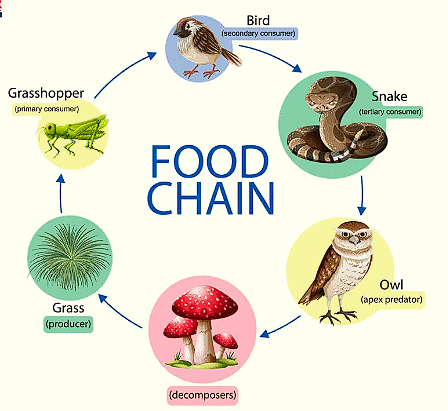
A food chain shows how energy and nutrients flow from one living thing to another in an ecosystem. Here’s a simple example:
- Sunlight: The sun provides energy for plants.
- Plants: Plants use sunlight to make their food through a process called photosynthesis. They are known as producers.
- Herbivores: Animals that eat plants are called herbivores. For example, a rabbit eats the plants.
- Carnivores: Animals that eat herbivores are called carnivores. For example, a fox eats the rabbit.
- Decomposers: When plants and animals die, decomposers like bacteria and fungi break them down and return nutrients to the soil.
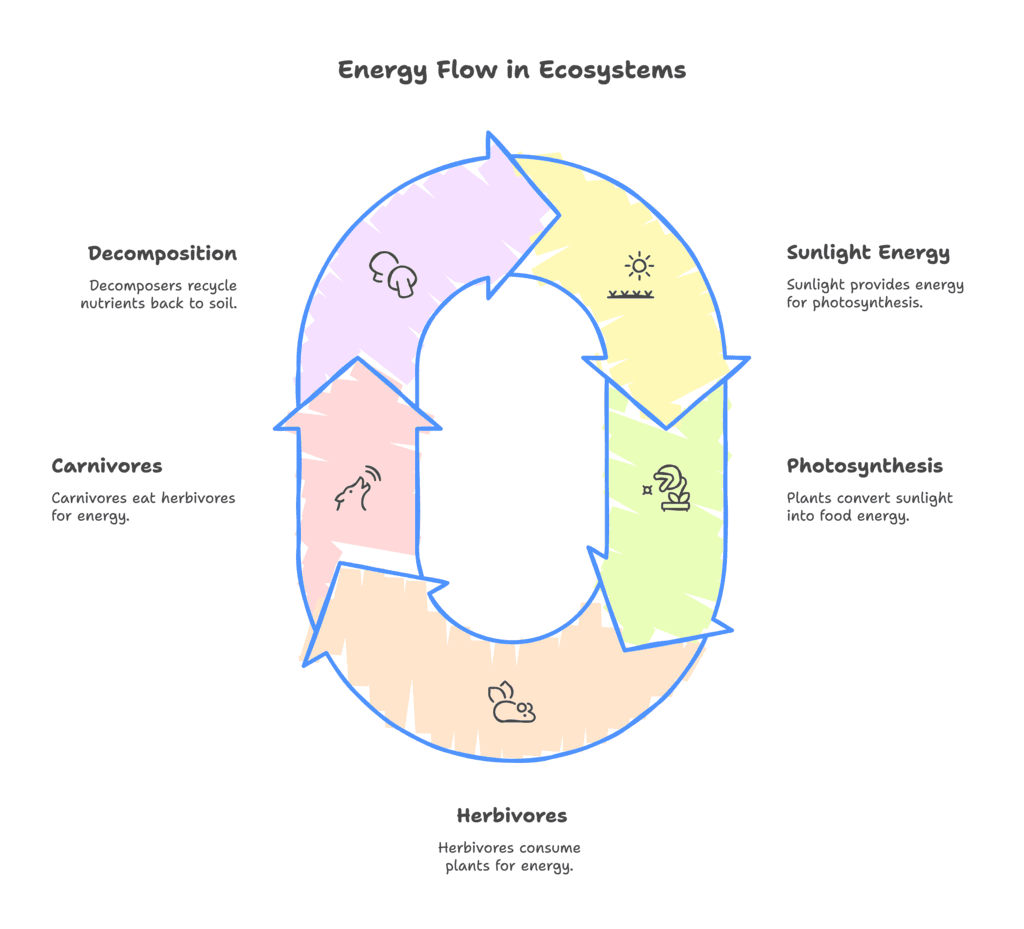
Note: Organisms and micro-organisms that dwell in the soil consume dead plant and animal matter, transforming it into a dark substance called humus. Humus aids in releasing nutrients from decaying plants and animals into the soil. Additionally, decomposed animal dung provides essential nutrients for growing seedlings.
Decomposers break down dead plants and animals into nutrients that enrich the soil. Some examples include:
These decomposers play a crucial role in recycling nutrients in ecosystems.
So, a simple food chain might look like this:
Sunlight → Plants → Rabbit → Fox → Decomposers.
This chain demonstrates how energy travels from the sun to plants, then to plant-eating animals, and finally to the animals that consume them, with decomposers recycling nutrients along the way. The forest is a vibrant and dynamic ecosystem, full of life.

What is a Food Web?
A food web is a map of many food chains in an ecosystem. It shows how different plants and animals are connected through what they eat. It helps us see all the different ways living things depend on each other for food.
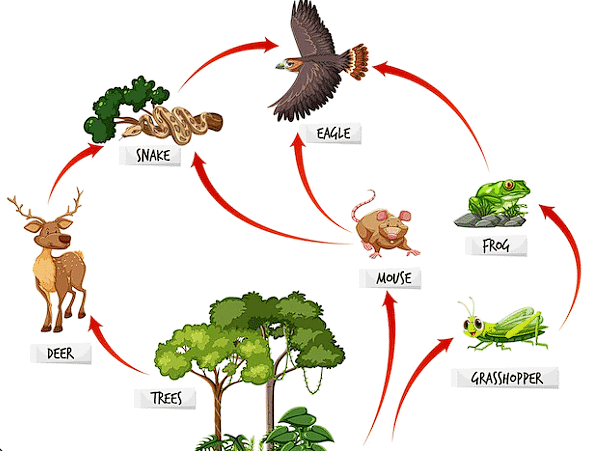
Why are Forests called Green Lungs of the Planet?
Forests are known as green lungs for various reasons like:
- Oxygen Production: Through photosynthesis, plants transform sunlight, water, and carbon dioxide into oxygen, which is vital for animals and humans to breathe.
- Support for Respiration: By producing oxygen, plants enable animals and humans to breathe, which is crucial for their survival.
- Atmospheric Balance: Plants are essential in controlling the levels of oxygen and carbon dioxide in the air. They absorb carbon dioxide and release oxygen, helping to keep the atmosphere stable.
- Influence on Climate and Water Cycle: Forests greatly affect the climate, water cycle, and air quality, thus promoting the overall health of the planet.
Due to their crucial role in producing oxygen and maintaining atmospheric balance, forests are often called the "lungs" of the Earth.
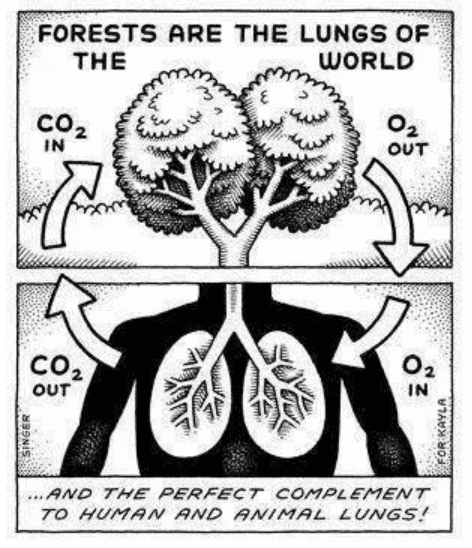
Why are Forests called Dynamic Living Entity?
Let's understand why forests are called a dynamic living entity:
- Diverse Plant Life: Forests are home to many different plants, providing food and shelter for herbivores.
- Support for Herbivores: More herbivores lead to greater food availability for various carnivores.
- Animal Diversity: The range of animals in forests helps with their regeneration and growth.
- Nutrient Recycling: Decomposers are key in recycling nutrients, which helps new plants grow.
Because of its vibrant plant and animal life, the forest is considered a "dynamic living entity," teeming with vitality and activity.
How do Forests Protect us against Floods?
Forests are crucial for managing water levels and safeguarding soil. They have a significant effect on the climate, the water cycle, and the quality of air, which are key to their protective roles.
- Rainwater Absorption: Prof. Ahmad noted that forests naturally absorb rainwater, allowing it to soak into the ground. This helps keep the water table stable throughout the year.
- Flood Control: Forests play a vital role in controlling floods and maintaining the flow of water in streams. They soak up excess rainwater, reducing runoff and preventing large accumulations of water.
- Stream Flow Maintenance: By managing how much water reaches streams, forests help ensure a consistent water flow.
- Soil Protection: The roots of trees hold the soil together, which prevents erosion. Without them, soil can be washed away, leading to land damage and loss.
Importance of Forests
- Forests provide essential resources for human survival, including timber, food, medicines, and industrial raw materials.
- They also play a crucial role in maintaining ecological balance by regulating rainfall, reducing noise pollution, preventing soil erosion, and supporting biodiversity.
What is Deforestation?
Deforestation is the process of cutting down or removing trees from a forest. This can happen to make space for farming, building, or other activities. When trees are removed, it can harm animals and plants that live in the forest and can lead to problems like soil erosion and loss of habitats. Deforestation threatens our lives and the environment.
Effects of Deforestation
- Deforestation leads to an increase in atmospheric carbon dioxide levels, contributing to climate change by raising Earth's temperature.
- Wildlife will suffer from lack of habitat and food sources.
- Deforestation can disrupt the natural water cycle, leading to soil erosion and increased flooding risks. This poses risks to both human lives and the environment.
Conservation of Forests
Forests can be conserved in a variety of ways:
Sustainable Logging: Cut trees in a way that lets the forest grow back.
Reforestation: Plant new trees where forests were cut down.
Protected Areas: Create parks and reserves to keep animals and plants safe.
Community Involvement: Get local people involved in taking care of forests.
Legal Frameworks: Make and follow rules to stop illegal logging.
International Cooperation: Work with other countries to protect forests.
Keywords
1. Canopy: The canopy is the thick layer of leaves and branches formed by the tops of trees in the forest. It blocks most of the sunlight from reaching the layers below, making it shady. Many animals live in this layer, using the abundant food and shelter it offers.
2. Crown: The crown of a tree is the upper part, including the branches and leaves or needles. It forms the topmost layer of the tree and is responsible for providing shade. Canopies consist of tree crowns.
3. Decomposers: Decomposers break down dead plants and animals into nutrients that enrich the soil.
4. Deforestation: Deforestation is the process of cutting down or removing trees from a forest. This can happen to make space for farming, building, or other activities.
5. Humus: Humus is a dark substance that forms in the soil when organisms and micro-organisms break down dead plant and animal material.
6. Regeneration: Regeneration of a forest is the process of a forest recovering and growing back after disturbances. Animals help this process in various ways - by decomposing and enriching the soil, as well as by seed dispersal.
7. Seed dispersal: Seed dispersal in a forest is the way seeds are spread from one location to another where they can grow. This can happen through various methods, such as being carried by wind, water, or animals. Animals disperse seeds by eating and dropping them, carrying them to new places, or having seeds stick to their fur or feathers.
8. Soil erosion: Soil erosion is the process where wind or water carries away the top layer of soil. This can lead to the loss of fertile soil, which is important for growing plants, and can cause problems like land degradation and reduced crop yields.
9. Understory: The understory is the layer just below the canopy, made up of smaller trees, bushes, and vines. It gets less sunlight because of the dense leaves above, leading to high humidity. This layer supports many different animals that thrive in these conditions.
|
112 videos|286 docs|28 tests
|
FAQs on Forests - Our Lifeline Class 7 Notes Science Chapter 12
| 1. What is the role of forests in maintaining ecological balance? |  |
| 2. How do forests contribute to human health and well-being? |  |
| 3. What are some causes of deforestation? |  |
| 4. What are effective methods for forest conservation? |  |
| 5. Why is it important to understand the concept of a food chain in forests? |  |
















